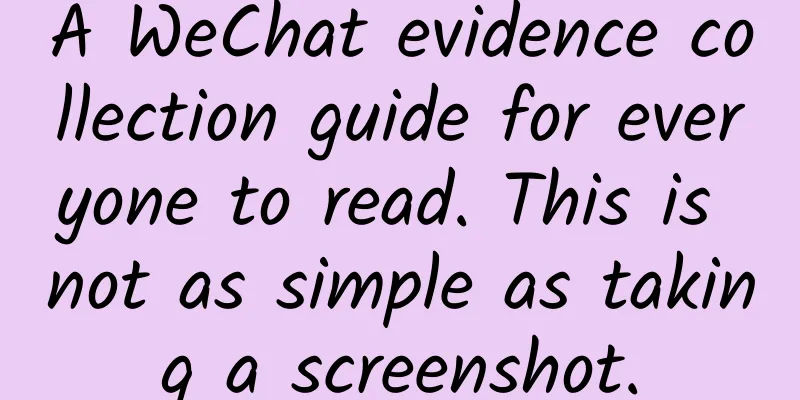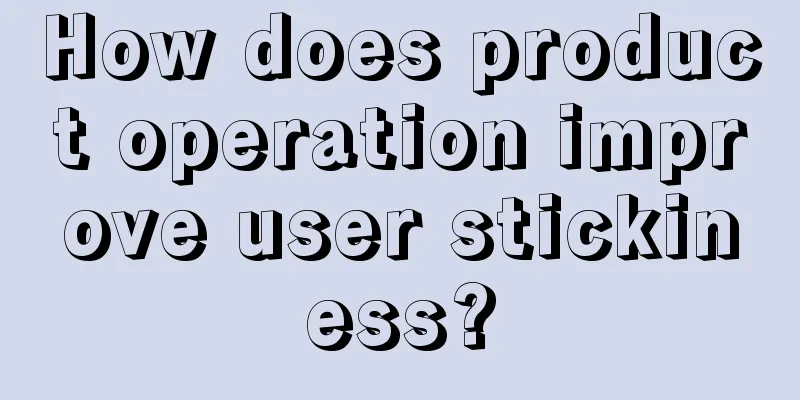A WeChat evidence collection guide for everyone to read. This is not as simple as taking a screenshot.

|
On July 18, 2018, the People's Court of Nansha District, Guangzhou City, Guangdong Province (the People's Court of Nansha District, Guangdong Free Trade Zone) issued the "Internet Electronic Data Evidence Proof and Certification Procedures", making "WeChat evidence collection" once again the focus of public attention. Therefore, this article will discuss the relevant issues of WeChat evidence collection (and other Internet social software evidence collection) from the perspective of legal practitioners. Basic principles of WeChat evidence collection Previously, evidence collection of social networking software such as WeChat and QQ has been included in the category of effective evidence. The introduction of the evidence collection procedures has further clarified the details of software evidence collection. The whole process is not as simple as "just intercepting chat records" as some netizens imagine. It requires the formation of a complete chain of evidence. Before you start collecting evidence, it is recommended that you first understand some basic principles of WeChat evidence collection so that you can draw inferences from one example: WeChat chat records as evidence must meet the "three characteristics" of "legality, authenticity, and relevance". That is, WeChat chat records must be obtained in accordance with the law and the source must be legal; the facts or content expressed must be true; and they must be closely related to the facts to be proved. Content related to the facts of the case shall not be provided selectively: WeChat chat records should fully reflect the conversation process, and content related to the facts of the case shall not be provided selectively. The court may request the supplementary provision of complete conversation records within a specified period. It should be noted that if the content of the conversation record is intentionally provided selectively, the corresponding legal consequences will be borne. Be sure to retain evidence of the other party's identity in the WeChat chat records: you can obtain confirmation through the other party's self-identification, locking the mobile phone number, or through chat details, WeChat avatars, WeChat albums, Moments, etc. If necessary, you can also request Tencent to assist in the investigation. All evidence should be fixed in time and collected on WeChat: All evidence should be fixed and saved as soon as possible to avoid the other party withdrawing, deleting, etc. For pictures, videos and other formats with a shelf life, you should download or collect them in time to avoid the loss of evidence and the inability to provide evidence. Simply put, WeChat evidence collection not only requires intercepting chat records, but also using screenshots, videos, and other means to prove to the court that the two parties in the conversation in the screenshot are the parties themselves. Although there are other points to note when collecting evidence on WeChat, knowing the above four points is enough to help you avoid possible errors during mobile phone operation. Next, let’s take a look at the correct way to collect evidence on WeChat. WeChat evidence collection method In judicial practice, WeChat chat records are usually collected through screenshots and video recordings. Screenshots are static fixes of WeChat chat records, while video recordings are dynamic fixes of the evidence collection process. The following uses the WeChat records involved in the transfer contract dispute case between Wang XX and Li XX as an example to demonstrate the specific steps of evidence collection. Even if you are not familiar with the process of fixing evidence, you can also follow the examples given below to take screenshots one by one (the pictures are coded for privacy, and the normal evidence collection steps do not require coding): Fixed personal information interface (proving that your WeChat is indeed yours): Prove the legitimacy of the WeChat chat records held by the individual and the authenticity of the individual’s identity. Search and fix the other party's personal information interface (to prove that the other party's WeChat is indeed his): With the immutable nature of WeChat ID, the real identity of the other party can be fixed by combining the mobile phone number, profile picture and other information displayed in the personal information interface. Group chat records require intercepting the group information interface and the personal information interface of the relevant persons one by one. Fixed chat records (to prove that you did say those words): Since WeChat chat records can only be deleted but not added in the terminal, compare the complete chat information in both parties' WeChat clients to verify the integrity and authenticity of the relevant information. If there is audio, please submit a text that is consistent with the audio content. If it contains pictures or texts, please submit the printed copies of the pictures and text files, that is, print out the pictures, tables, etc. in the conversation separately. In this way, WeChat evidence collection is basically completed. More considerations for WeChat evidence collection Taking screenshots is not the whole of WeChat evidence collection. After taking the screenshots, you also need to understand some legal considerations to avoid problems that may arise during subsequent identification and cross-examination. Evidence can be strengthened through notarization or time stamping: Currently, the commonly used methods of fixing evidence include notarization and electronic evidence solidification with time stamps. The authenticity can be confirmed through appraisal, and WeChat users bear the burden of proof for their own defense: as long as you have doubts about the authenticity of the evidence provided by the other party, you can apply for a judicial appraisal (usually you need to bear a certain amount of appraisal fees). In the scope of social software, forensic appraisal will check and judge whether the content of your screenshot is consistent with the actual chat content, whether it is generated by a dialogue generator, whether there is any deletion or modification, etc. It will also determine whether the account of the person concerned was in a stolen or abnormal state during the screenshot period. The original storage device should be kept and subject to cross-examination in court: the parties should keep the original carrier of electronic evidence for presentation in court. The original carrier includes mobile phones, computers or other electronic devices that store electronic data. This is a point that non-legal professionals often overlook when fixing evidence. In short, you should not only keep the screenshots, but also keep the electronic device (such as a computer, mobile phone, etc.) that you used to chat with the other party when the conversation took place. During the trial, the court may not necessarily require you to produce the original device, but if the other party raises questions and applies for identification, the original device plays a key role. Other evidence should be provided as much as possible to support the claim: if payment, transfer, red envelope and other functions are used, proof of payment and transfer should be provided; WeChat chat records will be more easily accepted if they can be corroborated with evidence such as supply orders, IOUs, and transfer vouchers. If there is only WeChat evidence but no other evidence to support it, there is a risk that it will not be accepted. Legal knowledge expansion This section focuses on telling you the legal basis and requirements for WeChat evidence collection, helping you to have a deeper understanding of evidence collection using Internet social tools including WeChat. Legal basis for WeChat chat records as evidence:
Requirements for WeChat chat records as evidence:
(Nick's note: This article was originally written by Daisy, a lawyer. Since she doesn't have a Matrix account, she posted it through me. I hope it can be helpful to you.) |
<<: Google's next-generation Android Q will restrict the operation of apps below 6.0 system
Recommend
Why isn’t your Tik Tok recommended? A guide to avoiding pitfalls on Tik Tok!
Three quarters of 2018 have passed in the blink o...
"Zunjie" is here, and the market value of Jianghuai, which is "attached" to Huawei, has soared to over 100 billion yuan. This time it really took off
In the past two days, the stock price of JAC Moto...
Solving the problem of intelligent car networking: Building an open ecosystem
my country's intelligent connected vehicles (...
Three ways to input wearable devices
[[125607]] With the development of wearable devic...
How much does a customized mini program cost? How much does it cost to customize a small program on the market?
How much does a customized mini program cost? How...
Green tongue, orange skin, black poop...maybe they're all caused by what you eat!
"Doctor! The child is urinating blood! Is th...
Zhulu Video Account 1.1 Operator Practical Operation Course New Platform New Opportunities, Build a Private Domain Traffic Position!
Zhulu Video Account 1.1 Operator Practical Operat...
The most comprehensive e-commerce operation plan for you!
What should a qualified e-commerce operation look...
Hongmeng Ecosystem Enters Second Phase, Accelerating Hongmeng Application in Thousands of Industries
[Shenzhen, China, January 18, 2024 ] Today , Huaw...
The boy who started the fantasy journey is a beggar eel? !
Searching for flower eels - Environmental DNA eco...
Can rockets be recycled? Check out these mind-blowing tricks!
Recently, Rocket Lab, an American company, reveal...
Facebook is losing its appeal? Maybe it can learn two things from Ingress
According to the latest survey by Piper Jaffray, ...
How can a newbie learn how to operate Douyin? Douyin operation strategy for beginners
The popularity of TikTok is self-evident. With th...
Domestic opinion is that this is normal: Apple App Store revenue is 70% higher than Google App Store
On April 16, data released by global app data ana...
Weaving, rapping, tilling the land...the "workers" in the cultural relics are also admirable!
Diligence is a traditional virtue of the Chinese ...









